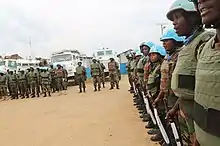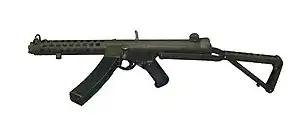Malawian Defence Force
The Malawian Defence Force[1] is the state military organisation responsible for defending Malawi. It originated from elements of the British King's African Rifles, colonial units formed before independence in 1964.
| Malawian Defence Force | |
|---|---|
 Coat of arms of Malawi | |
| Service branches | Malawi Army Malawi Navy Malawi Air Force |
| Leadership | |
| Commander-in-Chief and Minister of Defence | Lazarus Chakwera |
| Commander of the Defence Force | Vincent Nundwe |
| Manpower | |
| Military age | 18 |
| Conscription | 15–49 |
| Reaching military age annually | (2002 est.) |
| Active personnel | 25,500 (ranked 140th) |
| Expenditures | |
| Budget | $9.5 million (FY00/01) |
| Percent of GDP | 0.76% (FY00/01) |
| Industry | |
| Foreign suppliers | |
| Related articles | |
| History | Mozambican Civil War Operation Bwezani M23 Rebellion ADF Insurgency |
| Ranks | Military ranks of Malawi |
Malawi Army
Before independence, Malawi depended for its military supplies on the barracks in Rhodesia, as British colonial military logistics was usually considered on a continental scale & strategy, rather than at the level of individual colonies.[2] The Malawi Rifles were formed when the country gaining independence from the United Kingdom in 1964. Its first battalion was formed from the 1st Battalion, King's African Rifles. On independence the battalion became 1st Battalion, The Malawi Rifles (King's African Rifles). They were based at what became the headquarters of the Malawi Army at Cobbe Barracks, Zomba. Cobbe Barracks was named for British General Alexander Cobbe VC, who had served with the King's African Rifles. The Rifles were reportedly at a strength of 2,000 men at independence. On 6 July 1966 Malawi became a republic and Kamuzu Banda became the first president. After the swearing in ceremony his first duty was to present the battalion with his own presidential colour and the new regimental colour.[3] It was under the leadership of Brigadier Paul Lewis, a British expatriate.[4] By that year it appears that perhaps 60% of the officers in the battalion were former non-commissioned officers.[5]
Malawi was allied with Portugal during the Mozambican War of Independence, and the Malawian Army consequently cooperated with the Portuguese military to secure the Mozambican-Malawian border and arrest FRELIMO rebels. Following FRELIMO's victory and the independence of Mozambique, several Portuguese colonial secret police agents as well as FRELIMO deserters joined the Malawian Army.[6]
Declassified Defense Intelligence Agency reporting from 1985 states that "there is also a military college that is probably one of the finest, most efficiently organized, and operated military training schools in Sub-Saharan Africa. [It] conducts recruit training, numerous enlisted courses, officer cadet courses, [a] platoon leader course, company commanders course (sic), communications courses, NCO courses, a catering course, and will add a staff officers course in the future."[7] The same source listed the Army Commander as General Melvin Khanga, with the deputy commander, Lieutenant General Issac Yohane, and the Director of Training Major General Wilfred Mponela.
The Malawi Army is now made up of two rifle regiments and one parachute regiment. The military is organized under the purview of the Ministry of Defence. State Department IMET training documentation from FY 2003 indicates the United States trained army personnel from the 2nd Battalion, Malawi Rifles, 3rd Battalion, Malawi Rifles (Moyale Barracks), the Parachute Battalion, and the Combat Support Battalion (Mvera).[8]
In 1993, the army played a vital role in dismantling the dictatorship of Kamuzu Banda.[9] After Banda announced multi-party elections, the army intervened by dismantling Banda's paramilitary wing, the Malawi Young Pioneers in one night during an operation called "Bwezani" which means "taking back" or "returning". This event marked a vital point in the ideology of the Malawi Army that was to follow. The Malawi Army was shown to have no political aspirations themselves, and allowed the democratic process to ensue in Malawi as guided by civilians.[9]
On 5 April 2012 when President Bingu wa Mutharika died, there were rumours of an attempted constitutional coup intended to prevent vice-president Joyce Banda from becoming president as outlined by the constitution.[10] The military, under General Henry Odillo, stepped in and vowed to support and uphold the constitution of Malawi. They reportedly stationed security members at Banda's residence during the news of Mutharika's death.[11] This level of professionalism had a direct impact on the smooth transition of power.[10]
Malawi has signed the initial agreements joining the SADC Standby Brigade, the southern African component of the African Standby Force.
The Force Intervention Brigade of the United Nations Organization Stabilization Mission in the Democratic Republic of the Congo was authorized by the United Nations Security Council on 28 March 2013 through Resolution 2098.[12] Its first 2,550 troops were drawn equally from Malawi, the Tanzania People's Defence Force, and the South African National Defence Force.
Weaponry

Air Force
The Malawi Air Force was established with German help in 1976 with the delivery of six single engined Dornier Do 27s and eight Do 28 light twins in 1976-1980. Also in the same era the air force received an Alouette III, an AS 350 and an AS 355 Ecureuil, as well as three SA 330 H/L Puma Helicopters from France. A single BAe 125-800 was delivered in 1986. Four Dornier 228 light twin turbo props were acquired between 1986 and 1989 in part to allow disposal of the older Dornier products. In 1990 two Douglas C-47s and PT6A turboprops were delivered from the US.
Aircraft in 2021

| Aircraft | Origin | Type | Variant | In service | Notes | |
|---|---|---|---|---|---|---|
| Transport | ||||||
| Dornier 228 | Germany | Transport | 3[14] | |||
| Helicopters | ||||||
| Eurocopter AS350 | France | Light utility | 2[14] | |||
| Eurocopter AS350 | France | Transport | 1[14] | |||
| Eurocopter AS532 | France | Transport | 1[14] | |||
| Aérospatiale Gazelle | France | Light attack | SA341 | 2[14] | ||
| Aérospatiale SA330 | France | Utility/Transport | 2[14] | |||

Retired aircraft
Previous aircraft that have been place in storage or removed from service include the Basler BT-67,(Dornier Do27-A) British Aerospace 125, Hawker Siddeley 125, King Air 90, AS365 Dauphin, and the Alouette III.[15][16]
Navy
As a landlocked country, Malawi has a very small Navy with no sizeable military craft. Malawi's naval force only operates on Lake Malawi and is based at Monkey Bay. The Malawi Navy was organized in the early 1970s, with the help of the Navy of Portugal that ceded part of its boats of the Nyassa Flotilla operating from the then Portuguese province of Mozambique.[17] In some cases, the gunboats of the Malawian Navy were initially crewed by Portuguese.[6] In 2007, the navy had 220 personnel,[17] and operated the following vessels:
- Patrol boats
- 1 Namacurra-class harbour patrol boat (P 704 Kaning'a, formerly Y 1520), transferred from South Africa in 1988[17]
- 1 Antares-class patrol boat (P 703 Kasungu, formerly Chikala), out of service since 1993[17]
- Service craft
- 1 unknown-type Landing Craft Mechanized (P 702 Chikoko I), date of entry into service unknown[17]
- 12 Buccaneer Inflatables Buccaneer Legend-type rigid-hulled inflatable launches, in service since 1993[17]
See also
Notes
- "2011 budget document" (PDF). Sdnp.org.mw. Archived (PDF) from the original on 23 October 2014. Retrieved 23 October 2014.
- J.M. Lee (1969). African Armies and Civil Order. Studies in International Security. Institute for Strategic Studies. p. 58.
- https://web.archive.org/web/20120222132535/http://www.memoriesofrhodesia.com/pages/audio/troopingcolour.html. Archived from the original on 22 February 2012. Retrieved 9 April 2012. Missing or empty
|title=(help) - "Journal of Peace, Conflict and Military Studies". Malawi.freehosting.net. Archived from the original on 23 October 2014. Retrieved 23 October 2014.
- Lee 1969, 109.
- Finnegan (1992), p. 141.
- Defense Intelligence Agency (March 1989). "Military Intelligence Summary, Volume IV, Part I, Africa South of the Sahara (Southern and Central Africa)". p. 44/191.
- "Africa Region, Angola, DoD Regional Centers for Strategic Studies, FY 03" (PDF). State.gov. Retrieved 23 October 2014.
- REUBEN CHIRAMBO (2004). ""OPERATION BWEZANI": THE ARMY, POLITICAL CHANGE, AND DR. BANDA'S HEGEMONY IN MALAWI" (PDF) (13:2 ed.). University of Malawi, Malawi: Nordic Journal of African Studies. Archived from the original (PDF) on 11 February 2013. Retrieved 23 October 2014.
- "President Banda has her work cut out". Malawi Nyasa Times - Malawi breaking news in Malawi. Archived from the original on 15 April 2012. Retrieved 23 October 2014.
- "Potential crisis looms in Malawi amid reports of president's death - CNN.com". CNN. 7 April 2012. Archived from the original on 15 May 2012.
- "United Nations Security Council - Resolution 2098" (pdf). un.org. New York: United Nations. 28 March 2013. Retrieved 3 May 2017.
- Jones, Richard D.; Ness, Leland S., eds. (27 January 2009). Jane's Infantry Weapons 2009/2010 (35th ed.). Coulsdon: Jane's Information Group. ISBN 978-0-7106-2869-5.
- "World Air Forces 2021". FlightGlobal. 4 December 2020. Retrieved 5 January 2021.
- "World Air Forces 1987 pg. 68". flightglobal.com. Archived from the original on 21 July 2015. Retrieved 18 May 2015.
- l "World Air Forces 2000 pg. 75" Check
|url=value (help). flightglobal.com. Archived from the original on 7 March 2016. Retrieved 18 May 2015. - Wertheim, Eric (2007). The Naval Institute Guide to Combat Fleets of the World: Their Ships, Aircraft, and Systems. Annapolis, MD: Naval Institute Press. pp. 452–453. ISBN 9781591149552. Archived from the original on 6 July 2014. Retrieved 18 March 2014.
References
- Finnegan, William (1992). A Complicated War: The Harrowing of Mozambique. Berkeley, Los Angeles: University of California Press. ISBN 0-520-08266-4.
- World Aircraft Information Files. Brightstar Publishing, London. File 337 Sheet 02
- World Aircraft Information Files. Brightstar Publishing, London. File 340 Sheet 05
Further reading
- Crosby, Cynthia A. Historical Dictionary of Malaŵi. Vol. 54. Scarecrow Press, 1993. "Army" entry.
- Jonathan Newell, "An African army under pressure: The politicisation of the Malawi army and ‘Operation Bwezani’, 1992–93, Small Wars and Insurgencies, Vol. 6, No. 2, 1995, pp159-182, https://doi.org/10.1080/09592319508423107.
- Martin Rupiya (2005). "The odd man out: A history of the Malawi army since July 1964". Evolutions and revolutions: A contemporary history of militaries in Southern Africa (PDF). Institute for Security Studies.
- Tim Stapleton. "'Bad Boys': Infiltration and Sedition in the African Military Units of the Central African Federation (Malawi, Zambia and Zimbabwe) 1953-163." The Journal of Military History 73, no.4 (2009): 1167–1193.
.jpg.webp)

